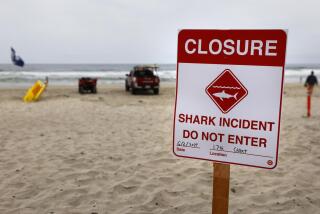Real people, real sharks, no cages
However scary were the “Jaws” that spooked beachgoers out of the water in summer 1975, that big, hungry great white was mostly mechanical. The sharks menacing a couple in this summer’s low-tech thriller “Open Water” are real.
Writer and director Chris Kentis (“Grind,” 1997) hired shark handlers to chuck chum -- chopped-up fish guts -- into the ocean. Jaws’ cousins arrived with their blood-stained maws and pointy teeth, and then the actors dived in.
The “questionary tale” about a vacationing couple mistakenly left behind in the middle of the ocean during a scuba diving excursion was shot in the Bahamas with a digital video camera for about $300,000. Kentis edited the movie with Final Cut Pro on a Mac G4, surrounded by drawings of barracudas and sharks done by his 6-year-old daughter, Sabrina. There are no mechanical monsters or computer-generated images.
So if those fins and murky shapes seem a little close, they are. The movie is schedule to hit theaters nationwide in August.
“The swimming with the sharks ... there’s a part of me that didn’t know if I could do that,” said actress Blanchard Ryan, who played Susan, the female lead. “It came down to me not breaking my word rather than being brave.”
“The bottom line is, I was really, really scared,” Ryan said, the opposite of her costar Daniel Travis, who couldn’t wait to shimmy into his wetsuit.
“In the fine tradition of adrenaline junkies, it was a great and exciting adventure for me,” Travis said. “First day, get in the water with sharks.”
Both actors, who appear to be in their 20s or early 30s but refused to disclose their ages, said that because of their vantage point in the ocean they never really knew when the sharks were close.
“She’d yell at me to stop kicking her, and I wasn’t,” Travis laughed. But he just went along with Ryan’s assumptions so she would stay in the water.
Ryan said the sharks aren’t what now keep her awake at night.
During filming, the sharks “were in a feeding frenzy, covered with blood -- and they had no interest in us,” she said. What gives her nightmares is the thought of “looking at the water at eye-level, bobbing up and down.”
Both actors spent hours in the swelling waves at least 20 miles from shore. The challenge, they said, was staying close to the boat without getting brained, as well as being positioned at the correct angle to the camera. Dramamine was in full supply.
“In the later scenes, when it looks like we did some fantastic makeup work, that’s just the effect of marinating in the ocean,” Kentis said.
The movie is based on accounts he and his wife and the film’s producer, Laura Lau, have read in dive magazines. The couple said they have been recreational divers for 11 years.
“It’s interesting to me that we go off to these exotic locales and put our lives, our trust in the hands of strangers,” Kentis said, adding that he and Lau were committed to making the movie as real as possible, without villainizing the sharks. So, but for a flash of fins, the camera pretty much stays on the surface of the water.
“What you can’t see is more scary,” said Lau, 40, who also helped with the camera work. “You really can’t see into the water when you are on the surface.”
Kentis spent a better portion of his days hanging over the side of a boat, his camera encased in a plastic shield he built, so that he was at eye level with his sea-level actors.
“He took every risk we did,” Ryan said. “He was crazy with the sharks. They were biting his camera cases, and he would bang [them] on the nose and wrench it out of [their] mouths.”
What would have been way too close for comfort for most people, Kentis said, is the only way he would have done it. The 40-year-old, whose day job has been cutting trailers for movies such as “Sleepy Hollow” and “The Royal Tenenbaums,” said he is saddened by how often even the simplest things in movies are now computer generated.
“When you watched movies in the ‘70s and you saw a car wreck and you knew there was a stunt man in there -- that’s where the awe came from,” Kentis said.
It’s this awe and the palpable fear flowing off the screen that had Lions Gate Films vying for the film after its first showing, on the second day of the 2004 Sundance Film Festival, said Tom Ortenberg, president of Lions Gate Films releasing.
“Open Water” is in the process of being transferred to 35-millimeter film and getting some professional editing -- what Ortenberg called basic polishing for a rough diamond.
The film’s crew said they are still stunned by the frenzy over “our little home movie.”
“We never thought we would ever get in” to Sundance, Ryan said, and for a long time the film didn’t even have a title. “We just called it ‘the shark movie.’ ”
So the crew went to the festival in January with mental fistsful of tickets for all the other projects they thought they’d view. Not one of them ever made it to any other screening.
After three days of negotiations with studios, Kentis said, he tracked down his actors at a bar to share news of the film’s impending release.
“Chris walked up and said ‘Lions Gate,’ and then we had a drink,” Travis recalled. As for his good fortune, Kentis said he was just glad the movie made it through the festival “without getting booed.”
Ortenberg said it was the basic, core-level fear factor that had him bent on acquiring the film for Lions Gate.
“It’s difficult to create a broad-based commercial sensibility on a low budget,” Ortenberg said. “So, what a lower-budget film has to do to achieve the same commercial viability -- it has to evoke the same sense of passion in a moviegoer ... suspense, thrills that it may lack in pyrotechnics.”
“Real people, real sharks, no cages -- that’s a pretty impressive sell right there,” Ortenberg said. “Real people, real sharks, no cages -- that’s scary.”
More to Read
Only good movies
Get the Indie Focus newsletter, Mark Olsen's weekly guide to the world of cinema.
You may occasionally receive promotional content from the Los Angeles Times.










